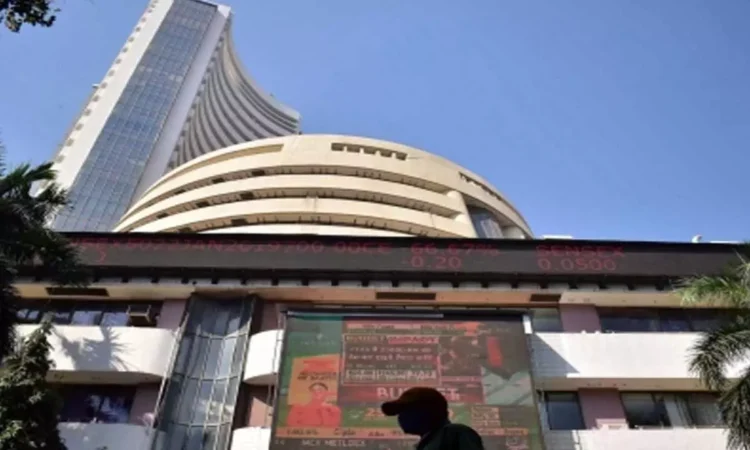The markets concluded their four-week winning streak, closing slightly lower due to a hawkish stance from the US Federal Reserve, mixed corporate earnings for Q2, renewed selling by foreign institutional investors (FIIs), and ongoing US-China trade negotiations. The Sensex fell by 273.17 points, or 0.32%, ending at 83,938.71, while the Nifty dropped by 155.75 points, or 0.60%, to close at 25,722.10. Conversely, the BSE Mid-cap Index rose by 1%, and the BSE Small-cap index increased by 0.7%. Following a brief buying phase, FIIs sold equities worth Rs 2,102 crore, while domestic institutional investors (DIIs) continued their buying spree for the 28th consecutive week, acquiring equities worth Rs 18,804.26 crore.
The Indian rupee finished near a record low of 88.77 per dollar, fluctuating between 87.85 and 88.78 during the week. The lack of substantial progress in discussions regarding the US-India trade deal further dampened sentiment, contributing to the cautious tone surrounding the currency. GST collections for October 2025 saw a year-on-year growth of 4.6%, totaling Rs 1.96 trillion, despite tax reductions implemented by the GST Council in September. The increase in domestic GST collections, even after significant rate cuts, is a positive sign indicating steady demand. Additionally, the consistent rise in GST refunds suggests confidence in tax administration, leading to expectations of a positive trend in future collections.
Next month’s data will reflect the full impact of the GST cuts and is highly anticipated. The political landscape is heating up with the first phase of Bihar elections beginning on November 6, featuring a competition between the NDA and Mahagathbandhan. The outcome of these elections may trigger immediate reactions in the markets. In the near term, markets are expected to remain range-bound, influenced by domestic earnings announcements and global macroeconomic developments. The upcoming holiday-shortened week promises to be eventful, with several key data releases and significant corporate earnings on the agenda. The IPO market is gearing up for a potentially record-breaking November, with issues worth Rs 76,000 crore on the horizon.
Major companies preparing for market debuts include Lenskart, Groww, ICICI Prudential AMC, Pine Labs, Cleanmax Enviro Energy, and Juniper Green Energy. This surge is attributed to a recovering secondary market, where the Sensex and Nifty increased by over 5% in October. The array of sectors represented spans technology, renewables, healthcare, and consumer goods, reflecting broad economic activity and investor enthusiasm. However, some analysts criticize the current exuberance, labeling it as potentially misguided, particularly in light of pre-IPO activities surrounding Lenskart, which they view as indicative of retail investor manipulation and flawed pricing strategies in India’s IPO market.
They argue that initial valuations are often set too high, leading to significant declines shortly after listing, as seen with companies like CarTrade, Nykaa, Zomato, and Paytm. Investors often misinterpret these dips as buying opportunities instead of reassessing the company’s fundamental value at the lower price. Market observers are calling for increased regulatory oversight on IPO valuations in India, especially in technology and consumer sectors, where many companies are backed by prominent venture capitalists and private equity firms. Predictions about market downturns are challenging, prompting many investors to focus on identifying strong companies capable of weathering economic fluctuations. In the futures and options segment, the settlement week saw considerable volatility.
Although initial sessions displayed a largely positive undertone, selling pressure in the latter part of the week erased early gains. The Bank Nifty outperformed broader indices, closing in positive territory, while the Nifty experienced a slight decline of about a quarter percent. On a monthly scale, the Nifty recorded its second-highest gain of the year. Sector-wise, the Nifty PSU Bank index increased by 4.7%, the Nifty Oil & Gas index rose by 3%, the Nifty Metal index gained 2.5%, and the Nifty Energy index went up by 1.8%. Conversely, the Nifty Healthcare, Auto, and Private Bank indices each fell by 1%.
In the options market, the highest call open interest for the Nifty was noted at the 26,000 and 25,900 strike levels, while significant put open interest was concentrated at the 25,800 and 25,700 strikes. For the Bank Nifty, notable call open interest was observed at the 58,000 strike, with substantial put open interest also at the 58,000 strike. Implied volatility for Nifty call options settled at 10.84%, while put options concluded at 11.89%. The India VIX, a key market volatility indicator, finished the week at 12.06%. The put-call ratio open interest stood at 1.14 for the week.
Nifty rollovers decreased to 75.79%, compared to 82.60% the previous month and below the three-month average of 80.64%, indicating a loss of momentum heading into the November series. Meanwhile, Bank Nifty rollovers were slightly higher at 79.57%, aligning closely with the three-month average of 79.11%. Support is now identified near 25,600, coinciding with the 20-day exponential moving average, and further down at 25,400, marked by trendline support. Resistance is anticipated around 26,100, and a sustained move beyond this level could pave the way for new record highs. Stocks that appear promising include Aurobindo Pharma, BEL, Canara Bank, Patanjali, Suzlon, SAIL, Sun Pharma, and UPL.
Conversely, stocks facing challenges include BSE, Exide Industries, Kotak Bank, ICICI Bank, LIC Housing, HDFC Life, and SRF.


